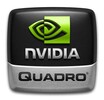NVIDIA Quadro M1200 vs NVIDIA Quadro M5500 vs NVIDIA Quadro 3000M
NVIDIA Quadro M1200
► remove from comparison
The 28 nm Nvidia Quadro M1200 is a mid-range DirectX 12 (FL 11_0) and OpenGL 4.5-compatible graphics card for mobile workstations. It is a (first generation) Maxwell-based GPU built on the GM107 chip with 640 shader cores. Therefore, the GPU is similar to the consumer Nvidia GeForce GTX 960M. The Quadro M1200M is built for the Intel Skylake generation and is the successor to the Quadro M1000M (950M based).
The Quadro series offers certified drivers that are optimized for stability and performance in professional applications like CAD or DCC. OpenGL performance, for example, should be significantly better compared to GeForce graphics cards of similar specifications.
Performance
The performance of the Quadro M1200 is on a level to the previous generation M2000M which is also based on the 960M. In games it is comparable to the GTX 960M although the driver support is not optimized for gaming.
Using CUDA (Compute Capability 5.0) or OpenCL 1.2, the cores of the Quadro M2000M can be used for general calculations.
Power Consumption
The power consumption of the Quadro M1200 is rated for the same TGP of 45 Watt (32.5 Watt TDP) and therefore a bit lower than the M2000M with 55 Watt TGP.
NVIDIA Quadro M5500
► remove from comparison
The Nvidia Quadro M5500 is a high-end, DirectX 12 (FL_12_1) and OpenGL 4.5-compatible graphics card for mobile workstations. It is a Maxwell-based GPU built on the GM204 chip with all 2048 shader cores activated and is manufactured in 28 nm at TSMC. Therefore, the GPU is similar to the consumer Nvidia GeForce GTX 980 (Notebook). Compared to the slower and less power hungry Quadro M5000M, the M5500 offers 512 more shaders which should result in 30-40% more performance according to Nvidia.
The Quadro series offers certified drivers that are optimized for stability and performance in professional applications like CAD or DCC. OpenGL performance, for example, should be significantly better compared to GeForce graphics cards of similar specifications.
Using CUDA (Compute Capability 5.2) or OpenCL 1.2, the cores of the Quadro M5000M can be used for general calculations.
The power consumption of the Quadro M5000M is rated at the same TGP of 150 Watt. Therefore, the card is suited for very large notebooks with 17-inch displays or greater.
The first laptop with the M5500 in it is the MSI WT72 Workstation.
NVIDIA Quadro 3000M
► remove from comparisonThe NVIDIA Quadro 3000M is a professional workstation graphics card based on the Fermi architecture (probably GF104 like the GeForce GTX 470M). Compared to the 5010M, the 3000M does not support ECC memory and DP floating point calculations.
The Quadro series offers certified drivers that are optimized for stability and performance in professional applications like CAD, DCC, medicine, or visualisation areas. The OpenGL performance for example should be significantly better than similar specified GeForce graphics cards.
The shader / CUDA cores can be accessed using DirectX 11, OpenGL 4.1 for graphic rendering and DirectCompute, OpenCL, AXE, and CUDA for general purpose calculations. Due to the new Fermi core, the 3000M should offer a high performance in general purpose calculations.
Furthermore, the Nvidia Quadro 3000M is compatible with the new stereoscopic solution by Nvidia called: NVIDIA 3D Vision Pro.
To automatically switch between the processor graphics card and the Quadro, the 3000M supports Nvidia Optimus (if the laptop vendor chooses to integrate it).
As the GeForce GTX 470M, the Quadro 3000M is specified at 75 Watt TDP and therefore only suited for large laptops with 17 inch displays.
| NVIDIA Quadro M1200 | NVIDIA Quadro M5500 | NVIDIA Quadro 3000M | |||||||||||||||||||||||||||||||||||||||||||||||||||||||||||||||||||||||||||||||||||||||||||||||||||||||||||||||||||||||||||||||||||||||||||||||||||||||||||||||||||
| Quadro M Series |
|
|
| ||||||||||||||||||||||||||||||||||||||||||||||||||||||||||||||||||||||||||||||||||||||||||||||||||||||||||||||||||||||||||||||||||||||||||||||||||||||||||||||||||
| Codename | N17P-Q1 | Fermi | |||||||||||||||||||||||||||||||||||||||||||||||||||||||||||||||||||||||||||||||||||||||||||||||||||||||||||||||||||||||||||||||||||||||||||||||||||||||||||||||||||
| Architecture | Maxwell | Maxwell | Fermi | ||||||||||||||||||||||||||||||||||||||||||||||||||||||||||||||||||||||||||||||||||||||||||||||||||||||||||||||||||||||||||||||||||||||||||||||||||||||||||||||||||
| Pipelines | 640 - unified | 2048 - unified | 240 - unified | ||||||||||||||||||||||||||||||||||||||||||||||||||||||||||||||||||||||||||||||||||||||||||||||||||||||||||||||||||||||||||||||||||||||||||||||||||||||||||||||||||
| Core Speed | 991 - 1150 (Boost) MHz | 1139 - 1140 (Boost) MHz | 450 MHz | ||||||||||||||||||||||||||||||||||||||||||||||||||||||||||||||||||||||||||||||||||||||||||||||||||||||||||||||||||||||||||||||||||||||||||||||||||||||||||||||||||
| Memory Speed | 5000 MHz | 6606 MHz | 625 MHz | ||||||||||||||||||||||||||||||||||||||||||||||||||||||||||||||||||||||||||||||||||||||||||||||||||||||||||||||||||||||||||||||||||||||||||||||||||||||||||||||||||
| Memory Bus Width | 128 Bit | 256 Bit | 256 Bit | ||||||||||||||||||||||||||||||||||||||||||||||||||||||||||||||||||||||||||||||||||||||||||||||||||||||||||||||||||||||||||||||||||||||||||||||||||||||||||||||||||
| Memory Type | GDDR5 | GDDR5 | GDDR5 | ||||||||||||||||||||||||||||||||||||||||||||||||||||||||||||||||||||||||||||||||||||||||||||||||||||||||||||||||||||||||||||||||||||||||||||||||||||||||||||||||||
| Max. Amount of Memory | 4 GB | 8 GB | 2048 MB | ||||||||||||||||||||||||||||||||||||||||||||||||||||||||||||||||||||||||||||||||||||||||||||||||||||||||||||||||||||||||||||||||||||||||||||||||||||||||||||||||||
| Shared Memory | no | no | no | ||||||||||||||||||||||||||||||||||||||||||||||||||||||||||||||||||||||||||||||||||||||||||||||||||||||||||||||||||||||||||||||||||||||||||||||||||||||||||||||||||
| API | DirectX 12 (FL 11_0), Shader 5.0, OpenGL 4.5 | DirectX 12_1, OpenGL 4.5 | DirectX 11, Shader 5.0 | ||||||||||||||||||||||||||||||||||||||||||||||||||||||||||||||||||||||||||||||||||||||||||||||||||||||||||||||||||||||||||||||||||||||||||||||||||||||||||||||||||
| Power Consumption | 45 Watt | 150 Watt | 75 Watt | ||||||||||||||||||||||||||||||||||||||||||||||||||||||||||||||||||||||||||||||||||||||||||||||||||||||||||||||||||||||||||||||||||||||||||||||||||||||||||||||||||
| Transistors | 1.9 Billion | 5.2 Billion | |||||||||||||||||||||||||||||||||||||||||||||||||||||||||||||||||||||||||||||||||||||||||||||||||||||||||||||||||||||||||||||||||||||||||||||||||||||||||||||||||||
| technology | 28 nm | 28 nm | 40 nm | ||||||||||||||||||||||||||||||||||||||||||||||||||||||||||||||||||||||||||||||||||||||||||||||||||||||||||||||||||||||||||||||||||||||||||||||||||||||||||||||||||
| Features | Optimus, PhysX, 3D Vision Pro, nView, Optimus | CUDA, 3D Vision, PhysX, GeForce Experience, Surround, GameStream, GPU Boost 2.0, Adaptive Vertical Sync, G-SYNC, SLI | OpenGl 4.1, FP32 | ||||||||||||||||||||||||||||||||||||||||||||||||||||||||||||||||||||||||||||||||||||||||||||||||||||||||||||||||||||||||||||||||||||||||||||||||||||||||||||||||||
| Notebook Size | large | large | large | ||||||||||||||||||||||||||||||||||||||||||||||||||||||||||||||||||||||||||||||||||||||||||||||||||||||||||||||||||||||||||||||||||||||||||||||||||||||||||||||||||
| Date of Announcement | 13.01.2017 | 04.04.2016 | 22.02.2011 | ||||||||||||||||||||||||||||||||||||||||||||||||||||||||||||||||||||||||||||||||||||||||||||||||||||||||||||||||||||||||||||||||||||||||||||||||||||||||||||||||||
| Link to Manufacturer Page | www.nvidia.de | ||||||||||||||||||||||||||||||||||||||||||||||||||||||||||||||||||||||||||||||||||||||||||||||||||||||||||||||||||||||||||||||||||||||||||||||||||||||||||||||||||||
| Shader Speed | 900 MHz |
Benchmarks
3DM Vant. Perf. total + NVIDIA Quadro 3000M
specvp11 snx-01 + NVIDIA Quadro M1200
specvp12 sw-03 + NVIDIA Quadro M1200
Cinebench R15 OpenGL 64 Bit + NVIDIA Quadro M1200
Average Benchmarks NVIDIA Quadro M1200 → 100% n=1
Average Benchmarks NVIDIA Quadro M5500 → 261% n=1
Average Benchmarks NVIDIA Quadro 3000M → 32% n=1
* Smaller numbers mean a higher performance
1 This benchmark is not used for the average calculation
Game Benchmarks
The following benchmarks stem from our benchmarks of review laptops. The performance depends on the used graphics memory, clock rate, processor, system settings, drivers, and operating systems. So the results don't have to be representative for all laptops with this GPU. For detailed information on the benchmark results, click on the fps number.

Doom
2016
The Witcher 3
2015
Thief
2014
BioShock Infinite
2013
Metro 2033
2010Average Gaming NVIDIA Quadro M1200 → 100%
Average Gaming 30-70 fps → 100%
| NVIDIA Quadro M1200 | NVIDIA Quadro M5500 | NVIDIA Quadro 3000M | |||||||||||||||||||
|---|---|---|---|---|---|---|---|---|---|---|---|---|---|---|---|---|---|---|---|---|---|
| low | med. | high | ultra | QHD | 4K | low | med. | high | ultra | QHD | 4K | low | med. | high | ultra | QHD | 4K | ||||
| Doom | 79 | 66 | 37 | 34 | 12 | ||||||||||||||||
| Rise of the Tomb Raider | 88.1 | 49.15 | 28.36 | 23.92 | 9.88 | ||||||||||||||||
| Batman: Arkham Knight | 74 | 63 | 35 | 29 | 11 | ||||||||||||||||
| The Witcher 3 | 73.6 | 45.9 | 28 | 13 | |||||||||||||||||
| Thief | 93.3 | 58.9 | 50.1 | 26.2 | |||||||||||||||||
| BioShock Infinite | 207 | 134 | 119 | 45 | |||||||||||||||||
| NVIDIA Quadro M1200 | NVIDIA Quadro M5500 | NVIDIA Quadro 3000M | |||||||||||||||||||
| low | med. | high | ultra | QHD | 4K | low | med. | high | ultra | QHD | 4K | low | med. | high | ultra | QHD | 4K | < 30 fps < 60 fps < 120 fps ≥ 120 fps | 5 1 | 3 2 1 | 2 3 1 | 4 2 | | 3 | < 30 fps < 60 fps < 120 fps ≥ 120 fps | | | | | | | < 30 fps < 60 fps < 120 fps ≥ 120 fps | | | | | | |
For more games that might be playable and a list of all games and graphics cards visit our Gaming List



















